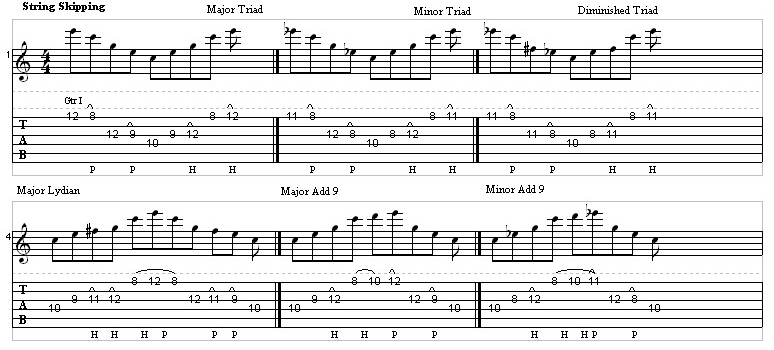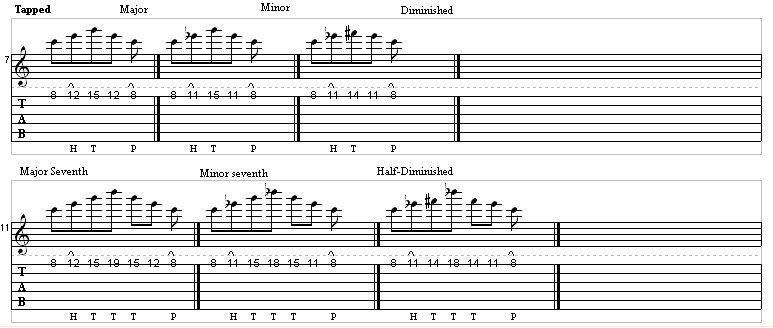Hey all, and welcome to the fourth and final (for now) installment of this series on arpeggios. In this column I will be discussing tapped and string skipping arpeggios. These will bring a very unexpected and fresh sound to the tried and true arps we all know and love. Let's get right to them shall we?
The first string skipping shapes we will look at are triad arpeggios. If your first impression is that they don't look like arpeggios to you, I would remind you that an arpeggio is the notes of a chord played individually. Here we have the root and third on the high E string, the fifth and third on the G string, and the lowest root on the D string. These are played using hammer-ons and pull-offs to get from string to string. Notice that the root is your first finger on the E string.
Because it is so easy to find the root, these arpeggios are great for outlining chord progressions, as well as playing diatonically. You can also add other interesting tones like ninths and raised elevenths to the basic patterns to increase the harmonic sophistication of the chords you are outlining, especially if they are power chords. The raised eleventh is a particular favorite of mine, and it really gives a great Lydian vibe to any major chord you play it over. Don't believe me? Check em' out!

Don't think for a second that these are the only variations available either. With these patterns you are only as limited as your imagination (and your grasp of harmony and chord theory).
When it comes to tapped arpeggios, the first shapes we will look at are simple triads on one string. While incredibly simple, these shapes have been used with great success by players like Randy Rhoads, George Lynch, Joe Satriani, and the list goes on. Remember, just because something is simple, that dosen't mean that it isn't the perfect tool for certain jobs.
These are fantastic for outlining chords, and because of their simple construction, it is very easy to switch from major, to minor, to diminished, to major seventh, to dominant, or to whatever you want. Just use your chord theory to tap the notes you need. If you want to extend the shapes even further, you can use multiple tapped notes on your tapping hand to really extend the reach of these "simple" shapes. Check out these examples to get started.

Alright folks, hopefully this series will be a pretty good introduction to arpeggios for the uninitiated, and will fill out the understanding of those of you already familiar with arpeggios. Does this cover everything related to arpgeggios? Nope, but it is a good start, and don't worry, we aren't done talking about arps yet, just done for the next few columns. Please feel free to drop me an email with any questions or comments, and I will do my best to get back to you in a timely manner. Rock on!
Scott Allen is a 1996 graduate of the Musician's Institute, G.I.T. He currently teaches guitar to 65 to 70 students weekly at Northridge Music Center.
His latest CD is entitled "III", featuring his impressively fluid playing, with a style marked by an incendiary sense of phrasing.